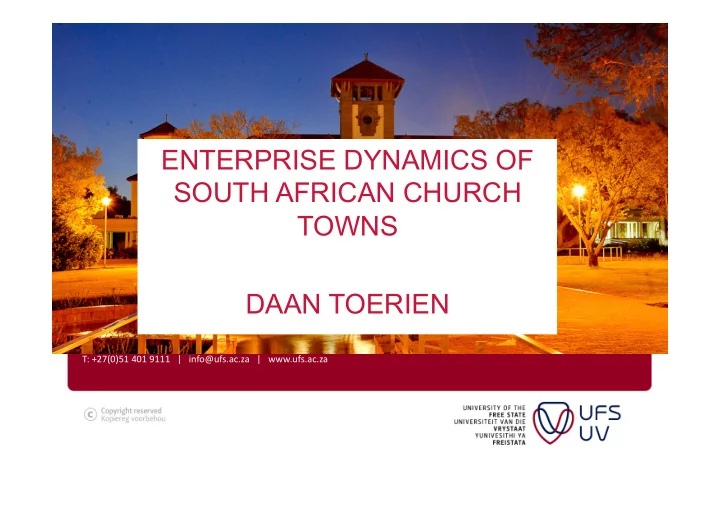

ENTERPRISE DYNAMICS OF SOUTH AFRICAN CHURCH FIRST AFRICAN WATER TOWNS CONFERENCE DAAN TOERIEN !"#$%&'()*+#,(+#-+++###.###/0123415678697###.###:::6415678697#
Introduction Hans Fransen ( Old Towns of the Cape) used the term “Church Towns” Towns that evolved when a church built when a new DRC parish was approved. “In many cases the newly founded church was the nucleus of a new town or village.” (M Tamarkin – Cecil Rhodes and the Cape Afrikaners: The Imperial Colossus and the Colonial Parish Pump) !"#(*+#,(+#-+++##/0123415678697### !!!"#$%"&'"(&)
Introduction By end of rule of the Dutch East Indies Co. in 1795 only 6 DRC congregations By 1854 there were 49 Fransen listed 148 towns founded up to 1900 in the Cape Colony of which 75 were church towns British Colonial Government played a crucial role !"#(*+#,(+#-+++##/0123415678697### !!!"#$%"&'"(&)
Introduction Three reasons why these towns represent important research material ! ! They were not founded to serve commercial or other purposes such as exploiting minerals Their enterprise structures can inform us about ‘normal’ enterprise dynamics of South African towns. !"#(*+#,(+#-+++##/0123415678697### !!!"#$%"&'"(&)
Introduction ! ! We have argued that towns are enterprise ecosystems This opens up the possibility to study towns with approaches and techniques used in natural ecology – will be used in this presentation. !"#(*+#,(+#-+++##/0123415678697### !!!"#$%"&'"(&)
Introduction ! ! Church towns can be considered to be “islands in a sea of farms” We have shown with data from Eastern Cape Karoo towns that the MacArthur-Wilson Species Equilibrium Model used in island ecology studies can probably be used to describe enterprise development in SA towns; a concept that needs further testing. !"#(*+#,(+#-+++##/0123415678697### !!!"#$%"&'"(&)
Purpose of this presentation The premise is that these towns all started the same way. So any discernible differences in their enterprise structures at present must reflect different evolutionary influences (and earlier growth potentials). To employ techniques used in ecological studies to show how enterprise development in church towns can be elucidated. !"#(*+#,(+#-+++##/0123415678697### !!!"#$%"&'"(&)
Nature of the analysis The process started with a selection of church towns (45), determining their enterprise architectures and then normalising the data before carrying out a clustering exercise. Each of the 45 church towns was correlated with all the others. The resultant correlation matrix was the input into the clustering analysis (complete linkage) !"#(*+#,(+#-+++##/0123415678697### !!!"#$%"&'"(&)
Clustering and proportionalities After clustering three ways of looking at the data are illustrated: 1. ! Principal component analysis 2. ! Comparing the different clusters 3. ! Proportionalities (regularities) were examined between sector enterprises and total enterprises. !"#(*+#,(+#-+++##/0123415678697### !!!"#$%"&'"(&)
!"#(*+#,(+#-+++##/0123415678697### !!!"#$%"&'"(&)
What causes the differences? *+,-'#./#,&.)0,12#'/%) &32)45,6-'5%)45'/1,) 71#,-%8)9) :1%;-/&.-/<)45'/1,) 7,&25)45'/1,) !"#(*+#,(+#-+++##/0123415678697### !!!"#$%"&'"(&)
Focusing on an enterprise sector 45 Church Towns 80 Tourism & Hospitality Sector (% of total) 70 60 50 40 30 20 10 0 !"#(*+#,(+#-+++##/0123415678697### !!!"#$%"&'"(&)
DE#,'E)71!3)D.#%/5,)'18;&,-%13) 05,'53/&+5)1$)/1/&.)3#8C5,)1$)53/5,;,-%5%) B>) D.#%/5,)?) B=) D.#%/5,)@) A>) D.#%/5,)A) A=) D.#%/5,)B) @>) D.#%/5,)>) @=) ?>) ?=) >) =) !"#(*+#,(+#-+++##/0123415678697### !!!"#$%"&'"(&)
Differences between clusters 45'/1,) D.#%/5,)?) D.#%/5,)@) D.#%/5,)A) D.#%/5,)B) D.#%/5,)>) *+,-'#./#,&.) B) @) ?) A) >) 0,12#'/%)9) 45,6-'5%) 71#,-%8)9) >) B) A) @) ?) :1%;-/&.-/<) 7,&2-3+) ?) A) B) >) @) ?)F)!5&G5%/H)@)F)%5'132)!5&G5%/H)A)F)8-22.5);1%-I13H)B)F)%5'132) %/,13+5%/H)>)F)%/,13+5%/) !"#(*+#,(+#-+++##/0123415678697### !!!"#$%"&'"(&)
Proportionalities- what they tell us 7,&25)45'/1,) @>=) 7E5) R#8C5,)1$)/,&25,%)-3)/1!3) <)F)="@>JKL)M)="??@K) 8#%-'&.) @==) NO)F)="PQQPK) 'E&-,%) ?>=) ;,1C.58) $1,)STU) ?==) ;.&33-3+) >=) =) =) @==) B==) K==) Q==) ?===) R#8C5,)1$)53/5,;,-%5%);5,)/1!3) !"#(*+#,(+#-+++##/0123415678697### !!!"#$%"&'"(&)
Proportionalities – more complexity 71#,-%8)9)E1%;-/&.-/<)45'/1,) ?K=) R#8C5,)1$)/1#,-%8)9)E1%;-/&.-/<) *;;&,53/) ?B=) .&'G)1$) <)F)="?A>BL)M)?"A=PP) ?@=) NO)F)="QPAQJ) 53/5,;,-%5%) %/,13+) ?==) ;,1;1,I1V Q=) 3&.-I5%) K=) B=) @=) =) =) @==) B==) K==) Q==) ?===) R#8C5,)1$)53/5,;,-%5%);5,)/1!3) !"#(*+#,(+#-+++##/0123415678697### !!!"#$%"&'"(&)
Proportionalities – more complexity 0,1;1,I13&.-I5%)V)!E&/)21)/E5<)/5..)#%) ?K=) R#8C5,)1$)/1#,-%8)9)E1%;-/&.-/<) 0,1;1,I13&.-/<) ?B=) <)F)="?BQL)M)="JJ@?) -3) ?@=) NO)F)="PP>>>) 53/5,;,-%5%) D.#%/5,)?) ;,1;1,I13&.-/<) ?==) D.#%/5,)@) Q=) D.#%/5,)A) <)F)="@JA>L)M)=">JQQ) D.#%/5,)B) K=) NO)F)="P??QB) D.#%/5,)>) B=) S-35&,WD.#%/5,)@X) <)F)="=QJJL)M)?"JJJ?) S-35&,WD.#%/5,)AX) NO)F)="P@B=?) @=) S-35&,WD.#%/5,)BX) =) =) @==) B==) K==) Q==) ?===) R#8C5,)1$)53/5,;,-%5%);5,)/1!3) !"#(*+#,(+#-+++##/0123415678697### !!!"#$%"&'"(&)
An avenue to explore !"#(*+#,(+#-+++##/0123415678697### !!!"#$%"&'"(&)
The SME Observatory 7E5%5)G-32%)1$)-365%I+&I13%)!-..)C5)#325,/&G53)-3)/E5) 41#/E)*$,-'&3)T3/5,;,-%5)YC%5,6&/1,<)/1)C5)E1#%52)!-/E-3) DU4H)Z[4)&32)\3&3'52)C<)/E5)[.58-%E)]165,3853/) /E,1#+E)/E5)^SY)&32)/E5)41#/E)*$,-'&3)7,5&%#,<")^/)!-..)C5) .'E52)13)A)U5'58C5,)E5,5)&/)/E5)Z[4)&32)/E5,5)-%)&3) -3$1,8&I13)%E55/)&6&-.&C.5)$,18)_1E&335%)`5%%5.%) !"#(*+#,(+#-+++##/0123415678697### !!!"#$%"&'"(&)
Recommend
More recommend